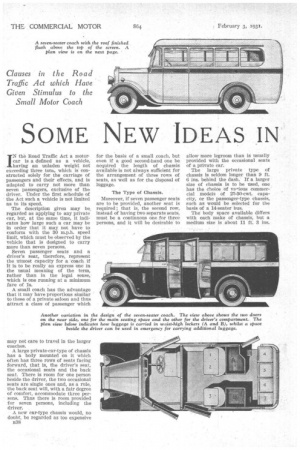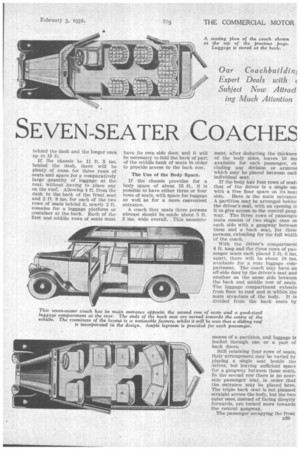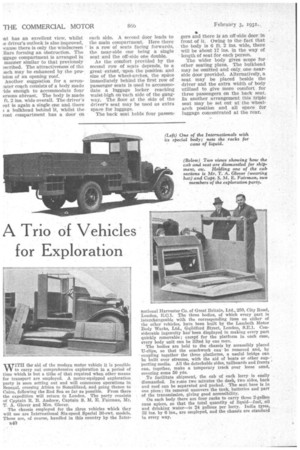SOME NEW IDEAS IN SEVEN-SEATER COACHES
Page 56

Page 57

Page 58

If you've noticed an error in this article please click here to report it so we can fix it.
Clauses in the Road Traffic Act which Have Given Stimulus to the Small Motor Coach
IN the Road Traffic Act a motor. car is a defined as a vehicle, having an unladen weight not exceeding three ton, which is constructed solely for the carriage of passengers and their effects, and is adapted to carry not more than seven passengers, exclusive of the driver. Under the first schedule of the Act such a vehicle is not limited as to its speed.
• The description given may be regarded as applying to any private car, but, at the same time, it indicates how large such a car may be in order that it may not have to conform with the 30 m.p.h. speed limit, which must be observed by the vehicle that is designed to carry more than seven persons.
Seven passenger seats and a driver's seat, therefore, represent the utmost capacity for a coach if it is to be really an express one in the usual meaning of the term, rather than in the legal sense, which is one running at a minimum
fare of Is. , A small coach has the advantage that it may have proportions similar to those of a private saloon and thus attract a class of passenger which may not care to travel in the larger coaches.
A large private-car-type of chassis has a body mounted on it which often has three rows of seats facing forward, that is, the driver's seat, the occasional seats and the back seat. There is room for one person beside the driver, the two occasional seats are single ones and, as a rule, the back seat will, with a fair degree of comfort, accommodate three persons. Thus there is room provided for seven persons, including the driver.
A new car-type chassis would, no doubt, be regarded as too expensive B38
for the basis of a small coach, but even if a good second-band one be acquired the length of chassis available is not always sufficient for the arrangement of three rows of seats, as well as for the disposal of luggage.
The Type of Chassis.
Moreover, if seven passenger seats are to be provided, another seat is required ; that is, the second row, instead of having two separate seats, must be a continuous one for three persons, and it will be desirable to allow more legroom than is usually provided with the occasional seats of a private car.
The large private type of chassis is seldom longer than 9 ft.
ins, behind the dash. If a larger size of chassis is to be used, one has the choice of various commercial models of 25-30-cwt. capacity, or the passenger-type chassis, such as would be selected for the basis of a 14-seater bus.
The body space available differs with each make of chassis, but a medium size is about 11 ft. 3 ins. behind the dash and the longer ones up to 13 ft.
If the chassis be 11 ft. 3 ins. behind the dash, there will be plenty of room for three rows of seats and space for a comparatively large quantity of luggage at the rear, without laving to place any on the roof. Allowing 4 ft. from the dash to the back of the front seat and 2 ft. 8 ins, for each of the two rows of seats behind it, nearly 2 ft. remains for a luggage platform or container at the back. Each of the first and middle rows of seats must have its own side door, and it will be necessary to fold the back of part of the middle bank of mats in order to provide access to the back row.
The Use of the Body Space.
If the chassis provides for a body space of about 13 ft., it is possible to have either three or four rows of seats, with space for luggage as well as for a more convenient entrance.
A. coach that seats three persons abreast should be made about 5 ft. 3 ins, wide overall. This measure
ment, after deducting the thickneR of the body sides, leaves 19 ins available for each passenger, ex eluding any division or armresi which may be placed between met individual seat.
If the body has four rows of seats that of the driver is a single on with a free floor space on its near side. Here is the main entrance A partition may be arranged behind the driver's seat, with an opening in it to give access to the central gangway. The three rows of passenger seats consist of two single ones on each side with a gangway between them and a back seat, for three persons, extending for the full width of the coach.
With the driver's compartment 4 ft. long and the three rows of passenger seats each placed 2 ft. 6 ins. apart, there will be about 18 ins. available for a rear luggage compartment. The coach may have an off-side door by the driver's seat and another on the same side between the back and middle row of seats. The luggage compartment extends from floor to roof and is within the main structure of the body. It is divided from the back seats by means of a partition, and luggage is loaded through one or a pair of back doors.
Still retaining four rows of seats, their arrangement may be varied by placing a single seat beside the driver, but leaving sufficient space for a gangway between these seats. In the second row there is no nearside passenger seat, in order that the entrance may be placed here. The triple back seat is not planned straight across the body, but the two outer ones, instead of facing directly forwards, are turned more towards the central gangway.
The passenger occupying the front 339 at has an excellent view, whilst le driver's outlook is also improved, cause there is only the windscreen liars forming an obstruction. The Iggage compartment is arranged in manner similar to that previously :tscribed. The attractiveness of the ach may be enhanced by the proision of an opening roof.
Another suggestion for a sevenpater coach consists of a body made ride enough to accommodate four ersons abreast. The body is made ft. 2 ins, wide overall. The driver's eat -is again a single Qne andthere 5 a bulkhead behind It, whilst the rent compartment has a door on
each side. A second door leads to the main compartment. Here there is a row of seats facing forwards, the near-side one being a. single seat and the off-side one double.
As the comfort provided by the second row of seats depends, to a greatextent,upon the position and . size of the wheel-arches, the space immediately behind the first row of passenger seats is used to accommodate a luggage locker reaching waist-high on 'each side of the gangway. The floor at the side of the driver's seat may be used as extra space for luggage.
The back seat holds four passen gers and there is an off-side door in front of it. Owing to the fact that the body is 6 ft. 2 ins, wide, there will be about 17 ins, in the way of length of seat for each person.
The wider body gives scope for other seating plans. The bulkhead may be omitted and only. one nearside door provided. Alternatively, a seat may be placed beside the driver and the extra width of body utilized to give more comfort for three passengers on the back seat. In another arrangement this triple seat may be set out at the wheelarch position and all space for luggage concentrated at the rear.




































































































